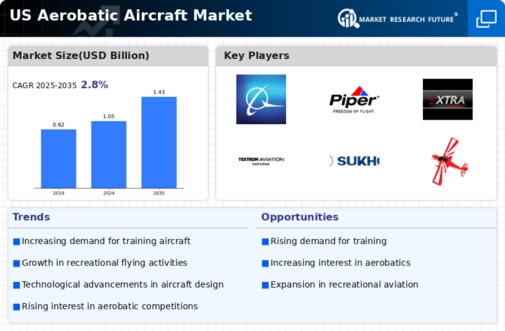The US Aerobatic Aircraft Market is characterized by intense competition among various manufacturers who aim to fulfill a niche yet demanding segment of aviation enthusiasts, flight schools, and professional pilots. This market has evolved significantly, driven by advancements in technology and increased interest in aerobatic performances and training. Manufacturers are continually innovating on performance, safety features, and operational costs to attract a broader clientele. The competitive landscape features a mix of well-established players and emerging companies focusing on specialized aerobatic aircraft, placing emphasis on unique capabilities and enhanced flight experiences.
This dynamic is compounded by factors such as regulatory changes, economic conditions, and evolving consumer preferences, which all play a vital role in shaping the competitive environment.In this marketplace, Bell Helicopter has carved out a notable presence with its specialized engineering capabilities and innovative designs, focusing on versatility and user-friendly operations within aerobatic contexts. The company is well-regarded for its robust R&D efforts, which allow it to stay ahead of competitors through technological advancements that enhance safety, maneuverability, and performance efficiency.
Bell Helicopter's strengths in this market can be attributed to their solid reputation in the aerospace industry as well as a strong support network for training and maintenance, ensuring that their aircraft meet the high expectations of aerobatic pilots and enthusiasts.
Their commitment to pushing the boundaries of performance in light aircraft further solidifies their standing in the US Aerobatic Aircraft Market, appealing to both solo pilots and flight schools.Boeing, as a historically significant player in the aerospace sector, also holds a key position within the US Aerobatic Aircraft Market, leveraging its vast expertise and resources to develop high-quality aircraft tailored for aerobatic needs. The company is known for its emphasis on quality and has achieved notable success with its innovative aerobatic offerings that combine advanced engineering with top-notch performance capabilities.
Key products and services include advanced flight training devices and aircraft that meet regulatory requirements for aerobatics, catering to both enthusiasts and professional pilots. Boeing's market presence in the US is bolstered by strategic partnerships, mergers, and acquisitions that enhance its product portfolio and expand its reach. The company's operational strengths stem from its commitment to research and development as well as a dedication to continuous improvement, ensuring that its aerobatic aircraft are not only cutting-edge but also safe and reliable for pilots of all skill levels.
Through these efforts, Boeing remains a formidable competitor in this specialized segment of the aviation industry.

















